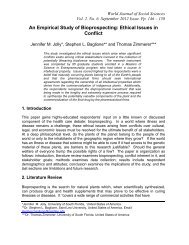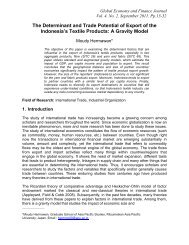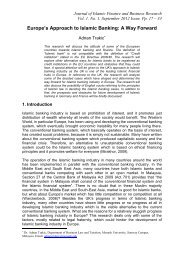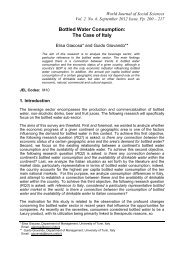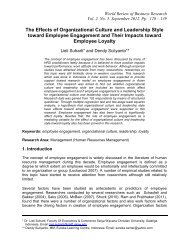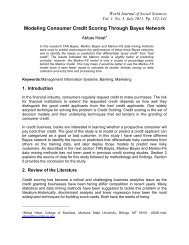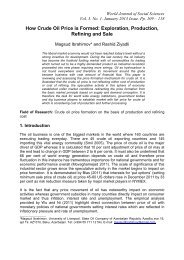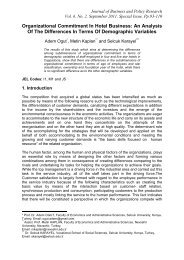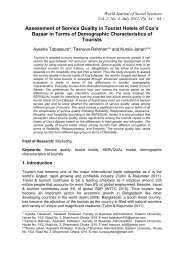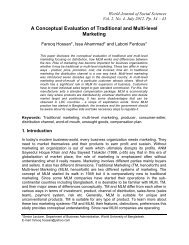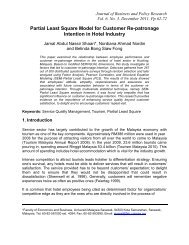Consequences and causes of inflation: A study in the ... - Wbiaus.org
Consequences and causes of inflation: A study in the ... - Wbiaus.org
Consequences and causes of inflation: A study in the ... - Wbiaus.org
Create successful ePaper yourself
Turn your PDF publications into a flip-book with our unique Google optimized e-Paper software.
Abdullah, Shamsher & Chowdhurypart <strong>in</strong> chang<strong>in</strong>g <strong>the</strong> global wea<strong>the</strong>r patterns <strong>and</strong> <strong>the</strong> agricultural sector is closely l<strong>in</strong>kedto climate change.Fourthly, oil price hike <strong>in</strong> recent years is widely blamed for supply disruptions <strong>in</strong> <strong>the</strong>Middle East <strong>and</strong> <strong>the</strong> Gulf <strong>of</strong> Mexico, geo-politics, rise <strong>in</strong> dem<strong>and</strong> (notably from emerg<strong>in</strong>gmarkets), <strong>and</strong> slides <strong>in</strong> <strong>the</strong> USD, <strong>in</strong>ter alia.Fifthly, <strong>in</strong>creas<strong>in</strong>g transportation cost (due to oil price hike) is also play<strong>in</strong>g a part <strong>in</strong>rais<strong>in</strong>g <strong>the</strong> prices <strong>of</strong> essential goods. The ban on exports <strong>of</strong> some essentials such asrice, wheat, lentil <strong>and</strong> onion by neighbor<strong>in</strong>g India has forced Bangladesh to procure<strong>the</strong>se products from o<strong>the</strong>r parts <strong>of</strong> <strong>the</strong> world. The ocean freight rates for gra<strong>in</strong>s has<strong>in</strong>creased more than hundred percent s<strong>in</strong>ce 2005-06 (Unnayan Onneshan, 2011). Thehigher energy cost also <strong>in</strong>creased <strong>the</strong> domestic distribution cost <strong>of</strong> commodities.Apart from all <strong>the</strong>se reasons, labor cost, <strong>in</strong>formation asymmetry, political unrest,dislocation <strong>in</strong> market structure due to anti corruption drives are responsible from recentprice hike.High <strong>in</strong>terest rate is also responsible for price hike as production is <strong>in</strong>creas<strong>in</strong>g.Bangladesh government is borrow<strong>in</strong>g from commercial banks excessively.Bangladesh‟s government borrowed about $700 million from commercial banks <strong>in</strong> July<strong>and</strong> August, <strong>the</strong> first two months <strong>of</strong> <strong>the</strong> new fiscal year, <strong>the</strong> central bank said on October1st. It will put private sector <strong>in</strong> open competition with government. It will raise <strong>the</strong><strong>in</strong>terest rate as well as price level. Moreover government is heavily borrow<strong>in</strong>g fromcentral <strong>and</strong> central bank is forced to pr<strong>in</strong>t money, which will also create <strong><strong>in</strong>flation</strong>.Specially, Excess subsidy <strong>in</strong> quick rental power plant (energy sector) forces governmenttoward budget deficit <strong>and</strong> mismanagement <strong>in</strong> overall economic coord<strong>in</strong>ation.4.3 F<strong>in</strong>d<strong>in</strong>gs <strong>of</strong> Objective 3Macro Economic Effect <strong>in</strong> BangladeshThe <strong><strong>in</strong>flation</strong>ary situation <strong>in</strong> Bangladesh is on <strong>the</strong> ris<strong>in</strong>g trend, especially s<strong>in</strong>ce August2009, primarily ow<strong>in</strong>g to <strong>the</strong> soar<strong>in</strong>g <strong>in</strong>crease <strong>in</strong> food prices. The food price hike hasaccelerated <strong>the</strong> general <strong><strong>in</strong>flation</strong> rate <strong>in</strong> <strong>the</strong> country. If <strong>the</strong> food price level rises at anexist<strong>in</strong>g rate <strong>of</strong> 1.31 percent per month <strong>and</strong> if adequate anti <strong><strong>in</strong>flation</strong>ary measures arenot taken, <strong>the</strong> overall general <strong><strong>in</strong>flation</strong> might touch a „double digit figure‟. The currentrate <strong>of</strong> rise <strong>in</strong> <strong><strong>in</strong>flation</strong>ary pressure suggests that <strong>the</strong> rate <strong>of</strong> general <strong><strong>in</strong>flation</strong> might reach10.71 percent by <strong>the</strong> end <strong>of</strong> this fiscal year <strong>and</strong> <strong>the</strong> food <strong><strong>in</strong>flation</strong> may reach to 12.84percent <strong>in</strong> June 2011 (Unnayan Onneshan, 2011).Should <strong>the</strong>re be double digit <strong><strong>in</strong>flation</strong>, this would pose a severe threat to <strong>the</strong> macroeconomicstability <strong>in</strong> <strong>the</strong> country. Bangladesh has already experienced a double-digitfood <strong><strong>in</strong>flation</strong> rate on po<strong>in</strong>t-to-po<strong>in</strong>t basis s<strong>in</strong>ce July 2007. The soar<strong>in</strong>g prices <strong>of</strong>essential commodities, especially, food prices could hurt <strong>the</strong> poor <strong>and</strong> worsen equity.Persistent high <strong><strong>in</strong>flation</strong> may unleash forces that jeopardize macroeconomic stability<strong>and</strong> economic growth. Last year, <strong>the</strong> International Monetary Fund (IMF) also warnedBangladesh that excess liquidity <strong>and</strong> resurgent <strong>in</strong>ternational commodity <strong>and</strong> food pricesmight push <strong><strong>in</strong>flation</strong> to double-digit levels by year-end (The Daily Star, 30 October.2009). We are now try<strong>in</strong>g focus on issues for <strong>the</strong> consequences <strong>of</strong> <strong><strong>in</strong>flation</strong>.96



